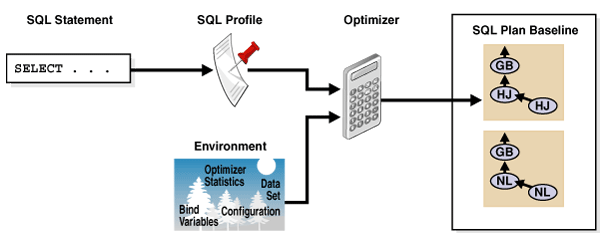This post highlights the differences between SQL profile and baselines in Oracle® and explains how it works when tuning a query.
Optimizer, profile, and baseline
At a high level, these three elements work together as follows:
- The query optimizer uses information like system statistics, bind variables, and compilations to get the best plan for query execution. However, sometimes input defects lead to a sub-optimal plan.
- SQL profiles contain auxiliary information that mitigates this issue. They minimize these mistakes and help the optimizer select the best plan.
- SQL plan baselines for SQL statements consist of a set of accepted plans. After parsing the statement, the optimizer selects the best plan from the set of accepted plans. If the cost optimizer finds another good plan, it adds the new plan to the plan history. However, the optimizer doesn’t use the new plan until it verifies that it will perform better than the currently accepted plan.
Think of it this way: SQL profiles give information to the optimizer to help select the best plan but don’t force the optimizer to select any specific plan. SQL plan baselines limit the optimizer plan selection to a set of accepted plans. If you want to consider cost-based plans, include them in the accepted baseline set of plans.
Use SQL profiles if you want the optimizer to use a least-cost plan and need to use the latest statistics. Use baselines when you want to use one of a specific set of plans. If SQL plan baselines can’t get the best plan from the accepted set, use the SQL profile instead.
SQL Plan Management
SQL Plan Management (SPM) has the following components:
- Plan capture
- Plan selection
- Plan evolution
SPM PLAN CAPTURE
When you execute any statement, the system hard parses it and generates a cost plan according to the available SQL profile. After it selects a cost-based plan, it compares the plans available in the SQL plan baselines. If a cost-based generated plan matches one of the accepted plans, then you can use that plan. If the plan does not match, the system adds it to the plan baselines as an unaccepted plan.
SPM PLAN SELECTION
When you execute the SQL statement with a baseline plan, it opts for the best plan for that SQL. The optimizer uses the same process. The available SQL profile also affects the estimated cost for each plan and selects a plan accordingly.
SPM PLAN EVOLUTION
The last component of SPM is the evolution of unaccepted plans, which tests the unaccepted plans against the accepted plans. This process assesses the best plan considering time taken by a query and the CPU resources required. It accepts the best plan according to the cost of the query. If an SQL profile is available, then it affects the estimated cost.
Profile versus baseline comparison
The following table, from https://www.cnblogs.com/princessd8251/articles/3637461.html, compares SQL profiles and SQL plan baselines:
Architecture
The following image shows SQL plan baseline architecture:
Image Source: https://ittutorial.org/sql-plan-management-using-sql-plan-baselines-in-oracle-oracle-database-performance-tuning-tutorial-14/)
Load SQL plan baselines
The following image shows two ways to load SQL plan baselines:
Image Source: https://ittutorial.org/sql-plan-management-using-sql-plan-baselines-in-oracle-oracle-database-performance-tuning-tutorial-14/
With the first method, you can set the OPTIMIZER_CAPTURE_SQL_PLAN_BASELINES initialization parameter to TRUE to use automatic plan capture. This initialization parameter is FALSE by default, so set it to TRUE as shown in the following example:
With the second method, you can use the DBMS_SPM package to enable manually manage SQL plan baselines. Load the plans from an SQL tuning set as shown in the following example:
LOAD THE SQL PLAN BASELINE MANUALLY
Use the following command to load the plan baseline manually:
Check the SQL plan baseline usage
After loading the SQL plan baseline, you need to execute SQL to see if the optimizer is using the SQL plan baseline. You can query the SQL plan baselines by using SQL_TEXT and the plan name as follows:
Display SQL plan baselines
Run the following query to display SQL plan baselines:
Drop the SQL plan baseline
To drop the SQL plan baseline, run the following query to check which SQL plan the optimizer is using:
Then, after you get the plan in use, run the following command to drop the baseline:
Oracle SQL profile
The SQL tunning advisor, which you trigger through Oracle Enterprise Manager (OEM) or by using a command-line query, can generate the SQL profile for an SQL statement. This profile includes additional information about the statement.
EXAMPLE
In this example, you first run SQL tuning advisor against the sql_id and then perform operations on the SQL profile:
1. RUN SQL TUNING ADVISOR
Run the following SQL tuning advisor code for sql_id, 6dkrnbx1zdwy38:

Run the following DBMS_SQLTUNE.report_tuning_task for recommendations:
2. ACCEPT THE SQL_PROFILE
Run the following code to accept the sql_profile:
3. CHECK THE NAME OF THE SQL_PROFILE
Use the following query to check the sql_profile name:
4. DISABLE THE SQL_PROFILE
Run the following code to disable the sql_profile:
To enable it, change the value from DISABLED to ENABLED.
5. DROP THE SQL_PROFILE
Run the following code to drop the sql_profile:
Conclusion
When you execute any SQL statement, the optimizer creates an execution plan to parse the query, retrieve the data from the hard disk, and place it in memory. The SQL profile and baselines guide the optimizer to choose the least costly plan in terms of time and CPU cost. A good SQL plan efficiently runs a query and provides the desired results faster.
credit: https://docs.rackspace.com/blog/oracle-sql-profile-and-baselines/
